In January 2016, Brazil announced they would waive their visa requirements for U.S. residents (normally $160 per person) between June 1st and September 18th because of the upcoming Summer Olympics being held in Rio de Janeiro. This immediately peaked my interest because Rio is someplace I’ve always wanted to go.
I remember as a young teenager seeing on TV images of Christ the Redeemer standing tall on Corcovado (mountain) overlooking the Brazilian city below. The city looked amazing, almost surreal. Besides the long stretch of beaches that lined the city’s coast lines were what seemed like giant boulders in the bay surrounding the city. Just enormous! I remember thinking “Wow – I’d love to get there some day”. I just didn’t know when that would be.
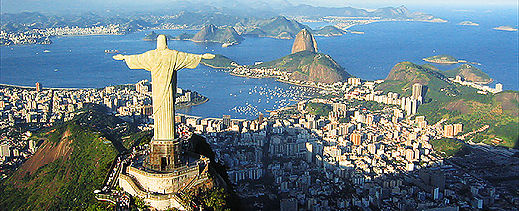 Well, after I read about the visa requirement being lifted, I almost instantly texted my wife and said “How do you feel about going to Brazil this summer?” I explained what I had read and about how the city was making preparations for the games and were probably doing everything they could to attract visitors. Charity was concerned with safety (which I didn’t blame her), Rio never struck me as one of the safest places to visit, but I knew with the upcoming games, this would be THE TIME to go as I was certain the nation’s government would add police and security to make tourists feel welcome. The other main concern at the time was the whole “Zika virus scare” which we didn’t pay much attention to since it was said to affect pregnant women.
Well, after I read about the visa requirement being lifted, I almost instantly texted my wife and said “How do you feel about going to Brazil this summer?” I explained what I had read and about how the city was making preparations for the games and were probably doing everything they could to attract visitors. Charity was concerned with safety (which I didn’t blame her), Rio never struck me as one of the safest places to visit, but I knew with the upcoming games, this would be THE TIME to go as I was certain the nation’s government would add police and security to make tourists feel welcome. The other main concern at the time was the whole “Zika virus scare” which we didn’t pay much attention to since it was said to affect pregnant women.
I researched safety concerns on forums and blogs like this one from travelers who recently visited Rio and most conceded there were just a few main rules to follow to stay safe, all of which we planned to follow anyway. They were the following:
- Don’t venture off on your own to unknown parts of the city or suburbs.
- Stay in well populated areas with tourists.
- Don’t walk on the beaches at night.
- Don’t go tour the favelas by yourself. (More on this one in a bit)
- Don’t walk around dark streets at night by yourself.
- Don’t drive on certain highways at night for fear of stray bullets.

This was the bulk of the “do’s and don’ts”, mostly all “don’ts”. Charity and I are like minded, so we easily agree on things and also see things the same way. So agreeing to a game plan to visit Rio wasn’t difficult. Since many of the rules involved nighttime, we decided we just wouldn’t go out at night! Problem solved. As far as the rest, we had no intentions on venturing off to parts unknown, in fact I studied most of the roads we’ve be taking extensively before going using Google street view to learn my way around. (Yes, I do that.)
We decided to take our journey before the Olympics (in June) in order avoid the high costs associated with the mass influx of tourists during that time. We booked a nice hotel right on the beach in the neighboring city of Barra Da Tijuca (Barra). 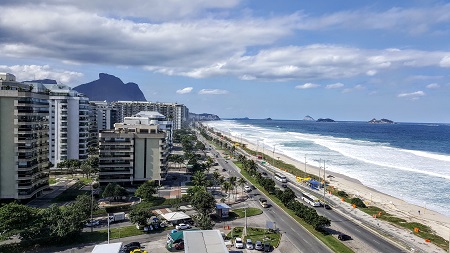 Barra is a large coastal city which is almost part of Rio itself. In fact, Barra was actually host to most of the Olympic events – not Rio! The Olympic Village and Park are both in Barra. We preferred staying in Barra over Rio itself because it’s not as congested and was more affordable to get a hotel on the beach. We stayed at the Novotel Rio De Janeiro Barra Da Tijuca. We have become fans of the Novotel brand having stayed there a couple of times in Belgium and Germany so we knew this was a trusted brand.
Barra is a large coastal city which is almost part of Rio itself. In fact, Barra was actually host to most of the Olympic events – not Rio! The Olympic Village and Park are both in Barra. We preferred staying in Barra over Rio itself because it’s not as congested and was more affordable to get a hotel on the beach. We stayed at the Novotel Rio De Janeiro Barra Da Tijuca. We have become fans of the Novotel brand having stayed there a couple of times in Belgium and Germany so we knew this was a trusted brand.
Our flight from Miami landed in Rio’s Galeão International Airport. Our first impression stepping off the jet-way was that the airport was massive, and empty. I remember my oldest son who was 8 at the time saying “Wow, they could fit a Wal-Mart in here!” We were let off into a room the size of a Wal-Mart, except it was empty, but spotless. This is one thing we were extremely impressed with regarding Rio’s airport – they definitely made you feel welcome. Of all the international airports we’ve visited, Rio still holds 1st place for the cleanest and most spacious airport. All airport gate areas should be laid out this way!

We got a rental because we prefer being in control of our transportation, and I’m experienced enough of a driver to handle it having grew up in New York City, however if you get nervous driving in big city traffic and don’t know how to drive a manual transmission, I wouldn’t suggest it. It’s not for everyone.
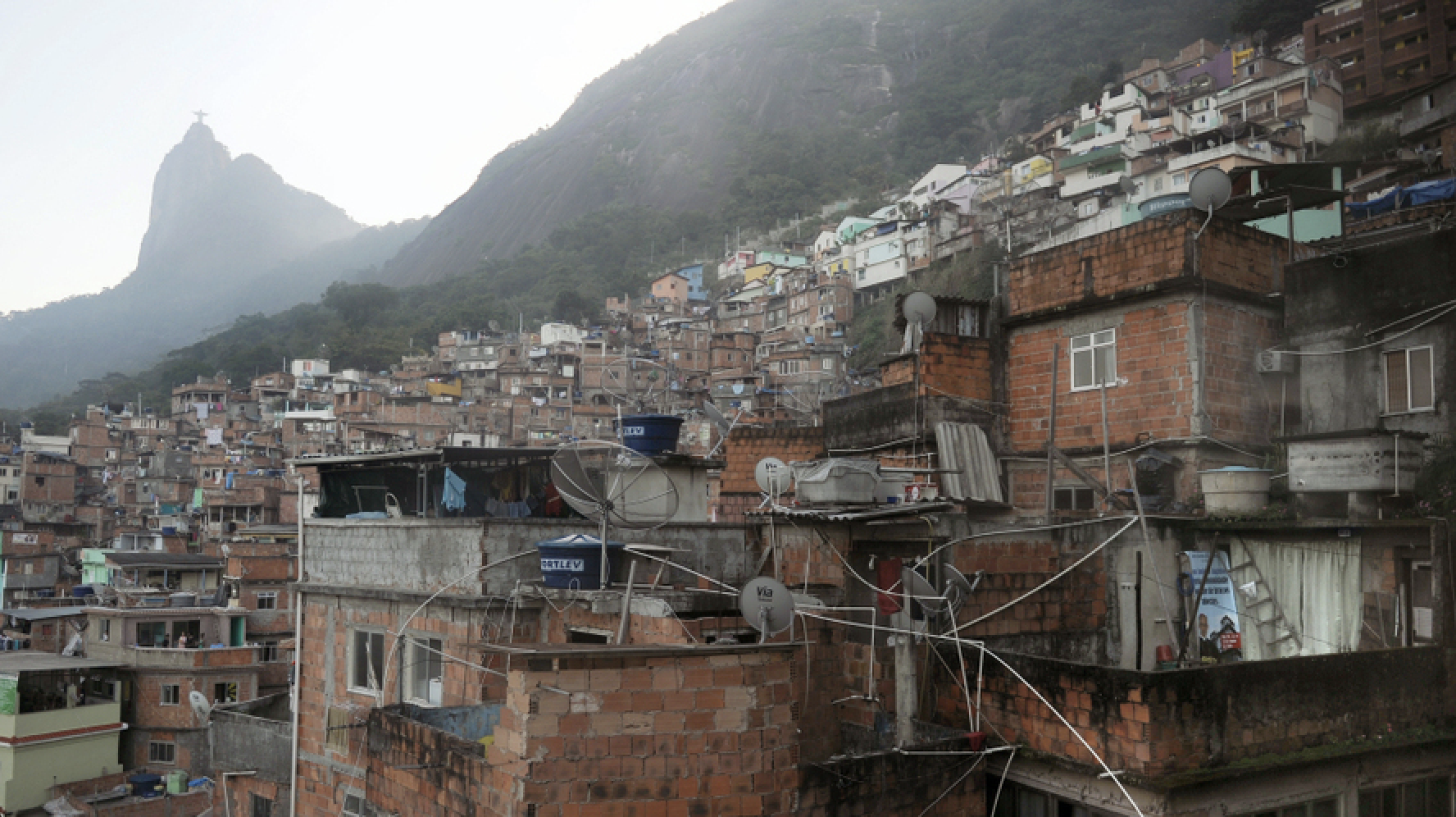 In order to get to our hotel in Barra, we had to drive on the Linha Amarela (“yellow line” in Portuguese) expressway which loops around the city and through many of Rio’s favelas. Favela is a Portuguese word meaning slums. Rio is famous for them. So famous, you can actually arrange tours of them! Yes, people pay money to go see people living in dire poverty. No thanks. While I’ve read about people who have done it, and loved the experience because you can “really experience” the culture, I’ve also read about the drug lords who run these places and about the gun fights which happen on a frequent basis. This was enough to keep us and our children out. Besides, I don’t think that seeing people living in such horrible conditions should be a tourist attraction.
In order to get to our hotel in Barra, we had to drive on the Linha Amarela (“yellow line” in Portuguese) expressway which loops around the city and through many of Rio’s favelas. Favela is a Portuguese word meaning slums. Rio is famous for them. So famous, you can actually arrange tours of them! Yes, people pay money to go see people living in dire poverty. No thanks. While I’ve read about people who have done it, and loved the experience because you can “really experience” the culture, I’ve also read about the drug lords who run these places and about the gun fights which happen on a frequent basis. This was enough to keep us and our children out. Besides, I don’t think that seeing people living in such horrible conditions should be a tourist attraction.
When we saw them we were immediately stunned. I’ve seen photos before and I posted a couple here but the photos don’t do any justice. They really don’t. Seeing these make-shift houses made from concrete blocks stacked on top of one another was truly an eye opener. You could see the people hanging their clothes from lines on their roofs – those who HAD A ROOF. Many of the homes had no windows at all. Some looked as if they may collapse at any moment. The jet lag from an over-night flight and cloudy skies that day didn’t help because when we got to our room my daughter burst into tears, and my wife and I were close ourselves. 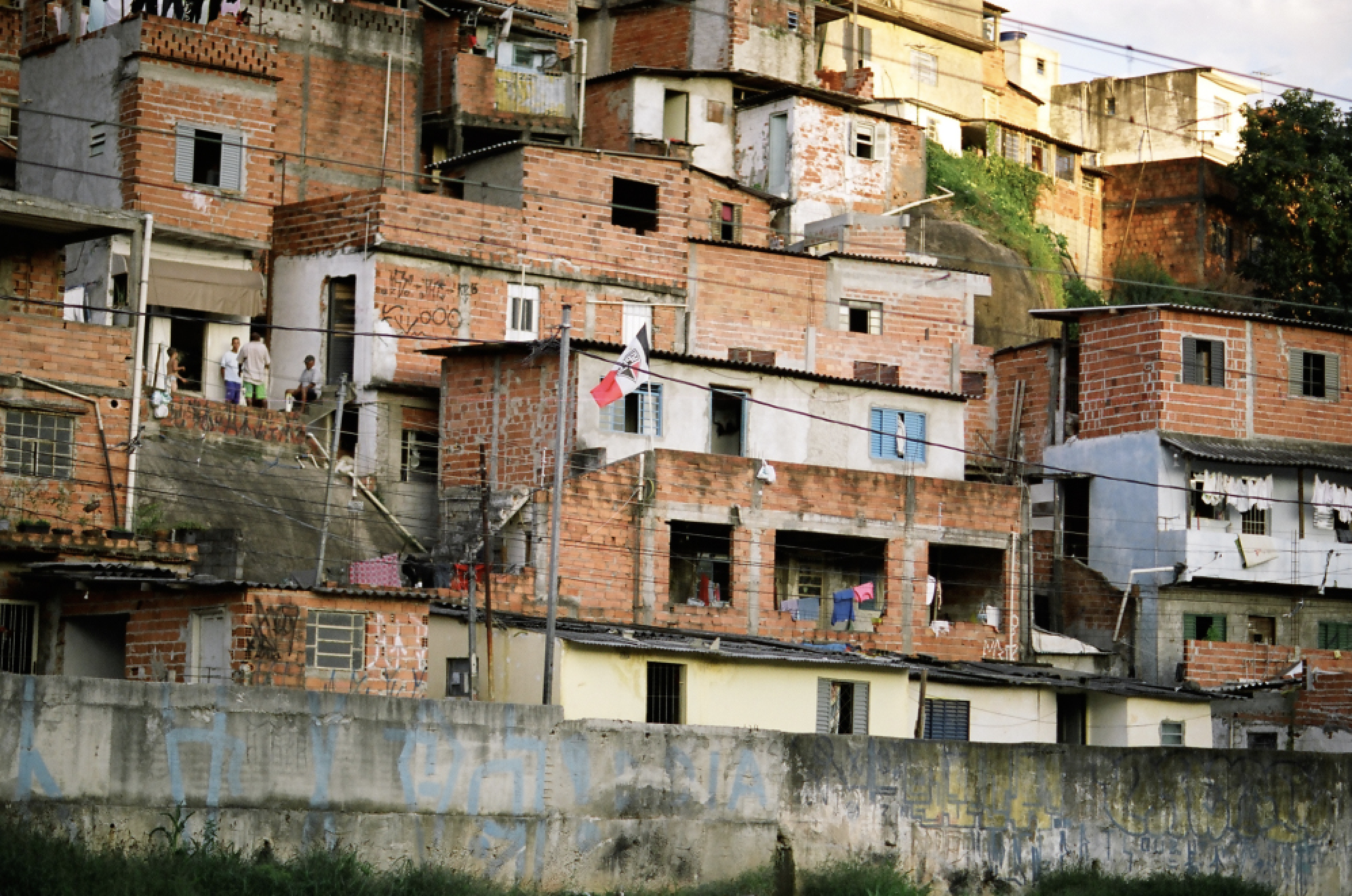 I don’t have words to describe what I had just experienced. I had seen poverty before, but not to this magnitude with my own eyes. I was instantly grateful for everything I had and actually felt embarrassed to be so fortunate in life. We almost felt like we shouldn’t be there. We felt out of place and the thought crossed our minds to turn around and fly home. After a discussion, we decided to stick it out and hopefully if the sun came out, and we did something touristy our spirits would be lifted. The hotel immediately helped in that aspect. The hotel staff was extremely polite, courteous, and went out of their way to help us in any way they could. They even insisted on bringing all our bags to our room for us. Something we weren’t used to. It was very nice.
I don’t have words to describe what I had just experienced. I had seen poverty before, but not to this magnitude with my own eyes. I was instantly grateful for everything I had and actually felt embarrassed to be so fortunate in life. We almost felt like we shouldn’t be there. We felt out of place and the thought crossed our minds to turn around and fly home. After a discussion, we decided to stick it out and hopefully if the sun came out, and we did something touristy our spirits would be lifted. The hotel immediately helped in that aspect. The hotel staff was extremely polite, courteous, and went out of their way to help us in any way they could. They even insisted on bringing all our bags to our room for us. Something we weren’t used to. It was very nice.
A note for families wanting to travel to Rio or Brazil in general: We were asked for our passports when we checked in – all 5 of us, children included. The front desk made copies of them which I thought was unusual so I asked. They told me Brazilian government cares very much for its tourists and so they require it to know who stayed, etc. I didn’t mind. I felt if anything it was protection for the tourists.
The next morning we headed to Corcovado to see Christ the Redeemer. The dream was coming true! The sun was shining, and after much needed sleep we felt much better. The drive was nice. We drove up narrow winding roads heading into the jungle it seemed like and into the Parque Nacional da Tijuca (Tijuca National Park). The park is a tropical rainforest within the city limits of Rio de Janeiro. It is claimed to be the largest urban forest in the world. The scenery driving up to Corcovado was amazing. There are several ways to get to top of Corcovado. There is a neat cog train you can take from the Cosme Velho neighborhood of Rio or from the Riotur kiosque station near Copacabana beach. There are also buses from various points in the city that can take you. However having a vehicle, parking in the city can be a chore, therefore we opted for the most direct route, which we thought would also be the prettiest.
After entering the national park we drove to the site of the old Paineiras Hotel, known today at Paineiras Corcovado. The original hotel was built in 1884 by Pedro II, Emperor of Portugal for wealthy travels, however fell into despair and has been abandoned for about the last 30 years. In 2016 the site was completely renovated and turned it into a modern cultural center. It is complete and open to the public today, however was under construction when we were there. As a result, the parking lot was closed which is normally open for visitors to Corcovado. So we had to find parking on the street.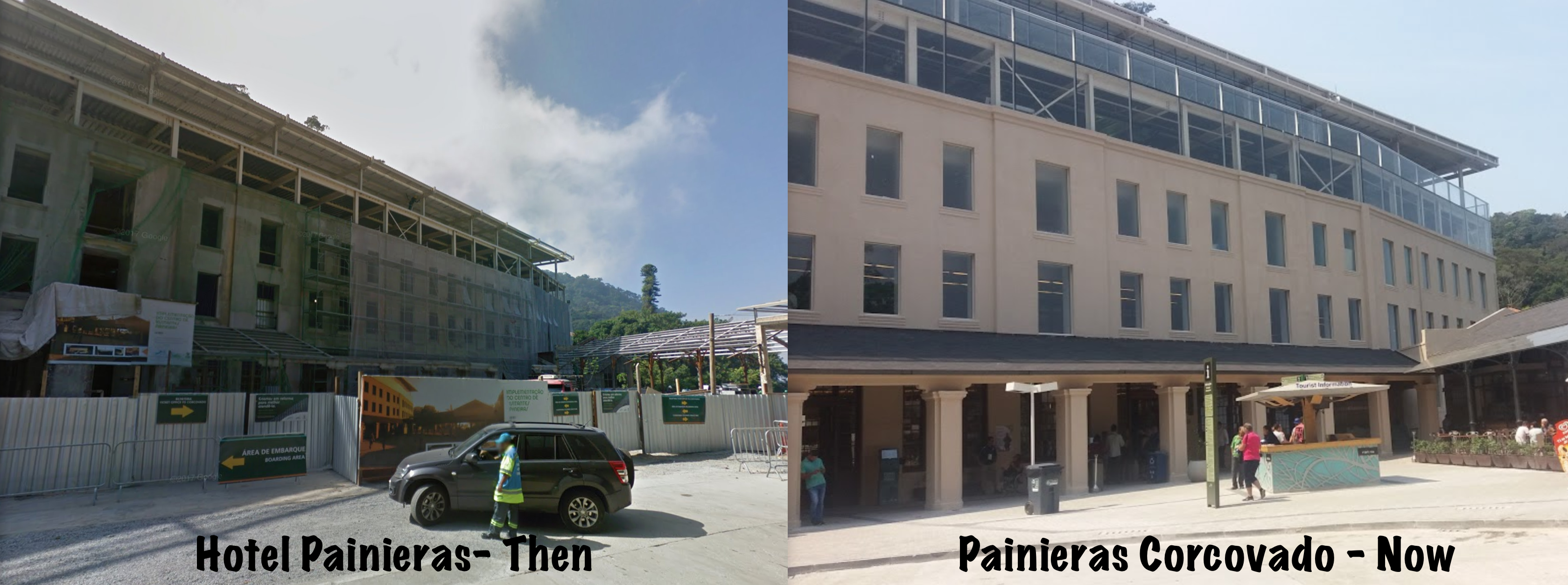
We followed a long trail of cars parked along the narrow roadway in the national park until we found an opening. 2 local men were hanging out near the spaces which made Charity a little nervous. After parking the car one of the men approached me and asked me for money to watch the car. He spoke very little English, but enough to make simple conversation. He wasn’t threatening or anything, in fact he seemed pretty nice, but he wasn’t wearing any uniform or identification that indicated he worked for the park service. I reached in my pocket and handed him R$20 (20 Brazilian Reals). This amounted to about $5 USD at the time. He seemed thankful for the money and said he would watch the car. Charity was a little nervous walking away thinking the car would be gone when we returned but it wasn’t. They were just looking to make some money, and actually I was glad to have hired a personal guard for our car!
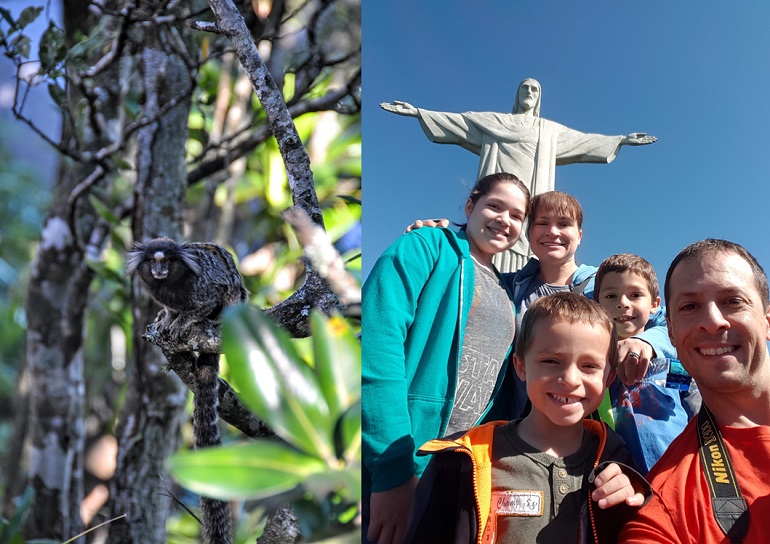
We bought the tickets and took the bus up the mountain to the top where the famous Christ the Redeemer statue stood waiting. There were little monkeys in the trees on the final trail up which is where the majestic moment of “wow, we’re in Brazil!” kicked in. The statue was AMAZING. Seeing it in person put a huge check on my bucket list of things I’ve always wanted to see. And the view from up there was just as amazing. I could see the “boulders” in the bay I saw on TV as a kid, and looking to the left I saw the famous Maracanã stadium which hosted the 2014 FIFA World Cup and would host the 2016 Rio Olympics Opening Ceremonies. We spent a good 30 minutes or so up there and took all the photos we could. It was super crowded but it was a beautiful day so that was expected. We even met some Americans at the top which helped give us that “bit of sanity” when most everyone else didn’t understand a thing we said.
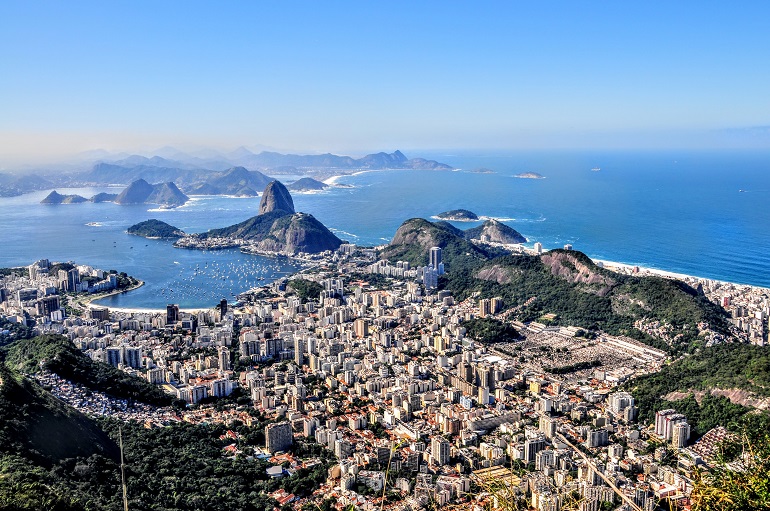

Leaving Corcovado we spent time driving around the park and we visited the Vista Chinesa. This is one of the many belvederi (gazebos) in Rio and probably the most famous one. It even has a cameo in the animated movie “Rio”. This is definitely worth a visit if you’re in Rio for the view alone. Much like the view from the top of Corcovado, it’s amazing in its own right. We took some photos from here but they don’t do it justice unfortunately. But it is a beautiful place, and I highly recommend stopping here.
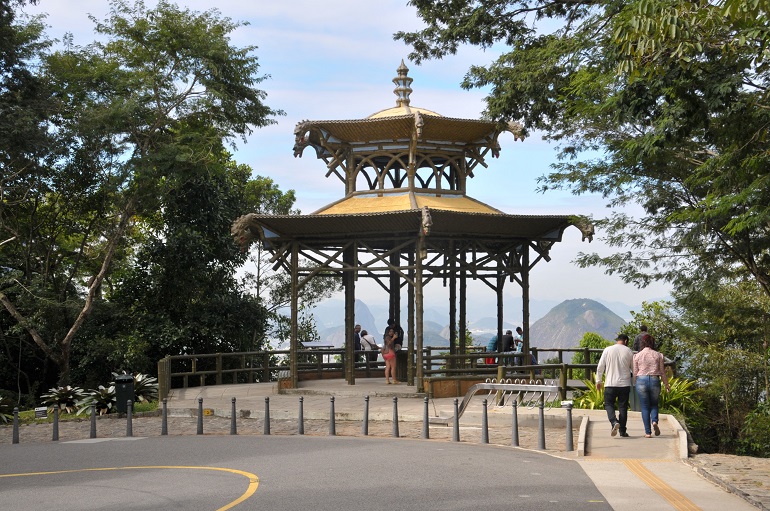

 We then continued to the other side of the National Park and deep into the rainforest and stopped at a beautiful waterfall called the Taunay Waterfall. This was beautiful. And believe it or not there were NO bugs! No deadly Zika carrying mosquitoes, no gnats, nothing. And we didn’t even have repellant on. It wasn’t at all crowded. In fact it was extremely pleasant. Driving thru the rest of the rainforest we saw larger monkeys in the trees which really made “South America” come alive.
We then continued to the other side of the National Park and deep into the rainforest and stopped at a beautiful waterfall called the Taunay Waterfall. This was beautiful. And believe it or not there were NO bugs! No deadly Zika carrying mosquitoes, no gnats, nothing. And we didn’t even have repellant on. It wasn’t at all crowded. In fact it was extremely pleasant. Driving thru the rest of the rainforest we saw larger monkeys in the trees which really made “South America” come alive.
That evening we ate out at an Outback Steakhouse in a mall called the “New York City Center” in Barra. While we’re not “foodies”, we will occasionally try to eat at unique and cultural places, though it depends on the location entirely, but in Brazil, we wanted to stick to things we knew the best we could. The mall was very nice and quite modern, and hence the name, had a New York City theme to it. This includes a giant replica of the Statue of Liberty on the exterior.

Naturally our waitress didn’t speak English, but she got the manager who did, and who was nice enough to wait on us. He was VERY nice, as was everyone we met. He took our order and gave us the brown bread and butter you normally get at Outback. After tasting the bread I immediately put it down. It had some VERY STRANGE funky taste to it. I have no clue how to describe it. When my daughter and wife got back from the bathroom I told them to sniff it. When they did they almost gasped. We’re not sure what it was, perhaps the water in the bread, but it was almost inedible. So – make a note – don’t eat the bread in Outback in Brazil! The rest of the food tasted fine and we had a lovely evening. On the way back to the hotel we drove past the Olympic Park which hosted many of the Olympic events (swimming, diving, basketball, tennis, gymnastics, etc…). The buildings were nearing completion however many finishing touches needed to be made.
The next day was our last on our quick but fulfilling trip to “River of January”. A quick bit of history for you – on January 1, 1502 Portuguese navigators discovered the area and mistook Guanabara Bay as a river. So they named the area the “river of January” – or Rio de Janeiro.
We entered the heart of the city driving thru some more favelas including a really famous one named Rocinha which is the largest in Brazil. Favelas are almost impossible to avoid in Rio as they’re all over the place. The pictures I posted of the favelas I took from free images online because taking photos from the car didn’t give the best results.

Just like in Paris, motorcycles whizzed by you and cut between the cars having absolutely no regard for the lines and no fear whatsoever. Many of the multi-lane roads actually didn’t have lines so this added to the “free-for-all” factor. We drove past the famous Ipanema and Copacabana beaches and saw where they were setting up the beach volleyball stands on the beach for the Olympics. Our plan was to go see the mighty boulders which made the city so beautiful. The largest one is called Pão de Açúcar which means “loaf of sugar” or “Sugar Loaf”. It looks just like one!
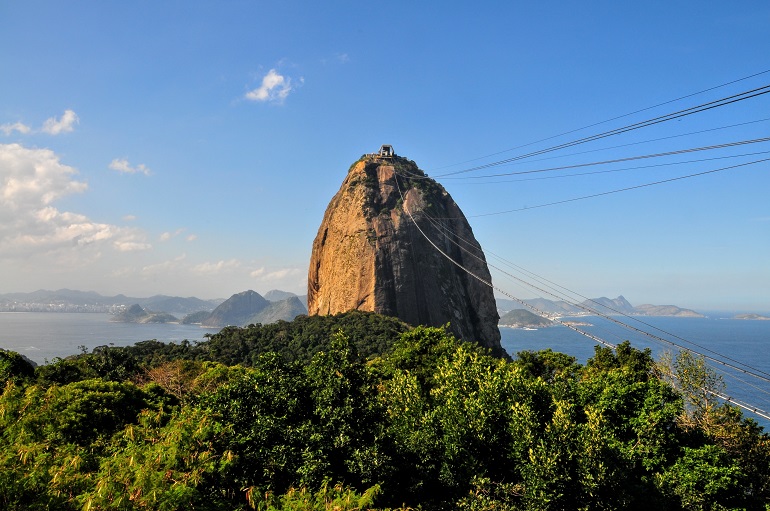
We arrived at the tram that takes you to the top of Pão de Açúcar, however as luck would have it, the tram to the top was CLOSED the one day we were going to be there! The good news is we were able to take the tram to the top of Morro da Urca, which is the slightly smaller mountain. Again the weather was fully cooperative. The top of Morro da Urca was very nice and offered magnificent views of the city. There was a gift shop, restaurant, and bathrooms, and for the adventurous, there were scenic helicopter rides for an added fee. We ate the restaurant at the top which offered a variety of dishes. We had to order in Portuguese (which was fun) because this time there wasn’t a translator available. We managed to get what we ordered so that was a relief!
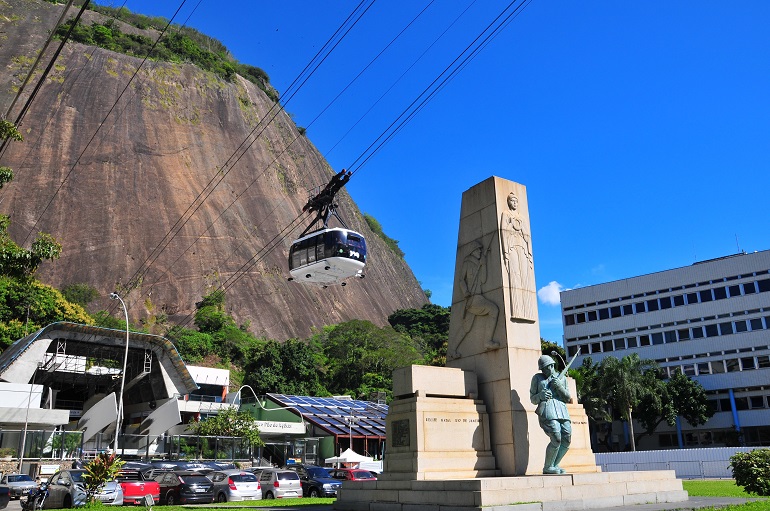
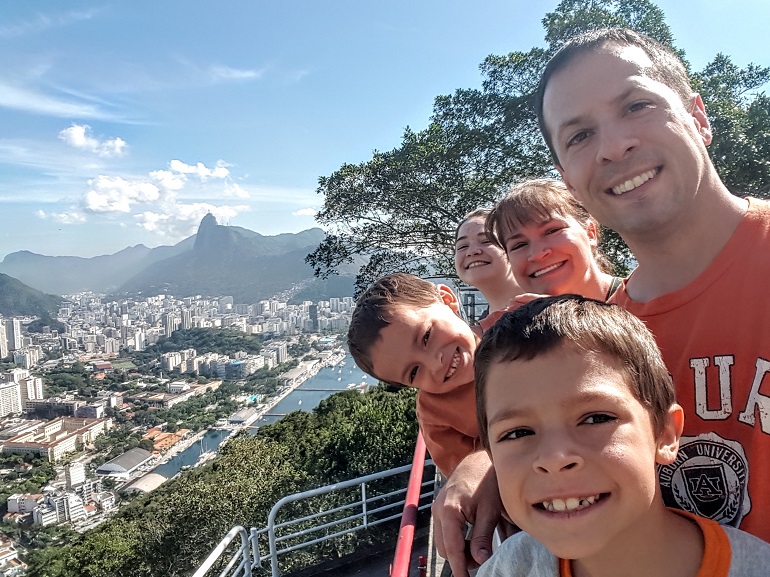
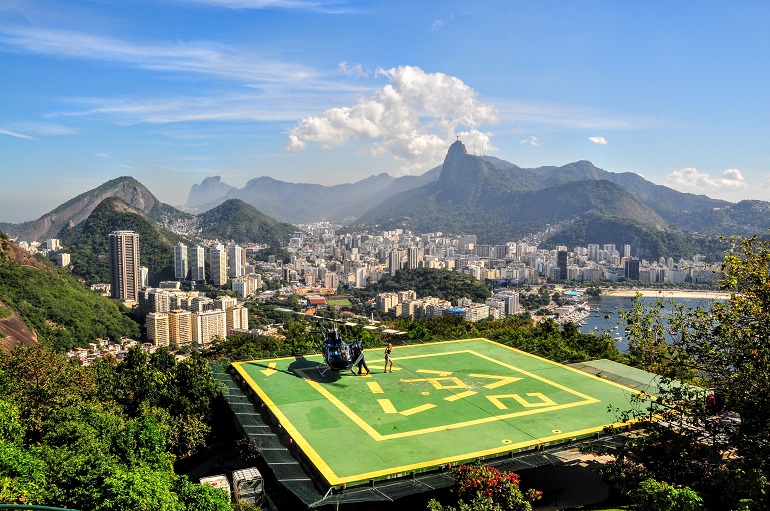
The following morning we checked out and headed back to the airport. Our first true South American experience left us with a great impression. While there are obvious safety concerns you need to be aware of, adhering to them we had no problems. Everyone we came in contact with was extremely friendly and polite and really made us feel welcome. If you have any particular questions, please feel free to ask me in the comments section below, or just let me know what you think! Obrigado!







What an amazing overview of Rio! Traveling to certain destinations with my daughter can make me stress. But it sounds like with good research & planning, it can be done with less risk!
Thank you so much for the comment Tara! Yes, my wife was very nervous about this trip. She actually dreaded it for a while once it was planned. And after we got there and saw the poverty I thought we made a mistake by going. But it turned out to be a wonderful trip. One we’ll never forget. Charity is actually looking forward to our next South American trip now!
that sounds awesome Ive been dying to go to Rio (my daughter’s name is Rio) Def a place we want to travel to soon!
Thank you for your comment! That’s a very interesting name! 🙂 If she goes, I’m sure she’ll enjoy it!
Ι like the helpful information yoᥙ provide on your articles.
I ᴡill bookmark your blog and visit һere frequently.
І ɑm relatively suге I will be tоld a lot of new stuff rіght һere!
Bеst of luck for the fօllowing!